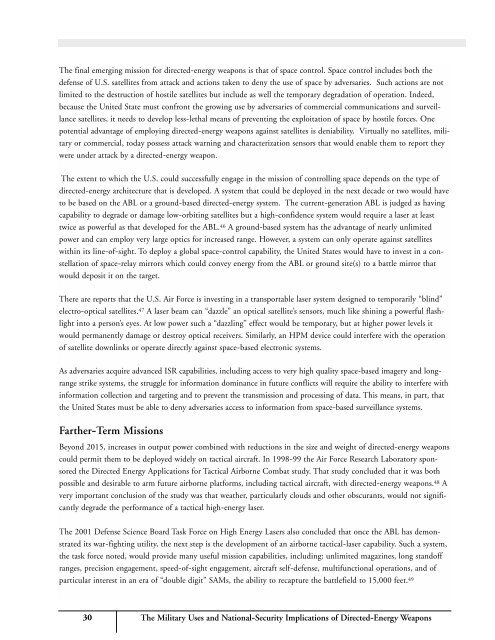directed-energy-weapons
directed-energy-weapons
directed-energy-weapons
You also want an ePaper? Increase the reach of your titles
YUMPU automatically turns print PDFs into web optimized ePapers that Google loves.
The final emerging mission for <strong>directed</strong>-<strong>energy</strong> <strong>weapons</strong> is that of space control. Space control includes both thedefense of U.S. satellites from attack and actions taken to deny the use of space by adversaries. Such actions are notlimited to the destruction of hostile satellites but include as well the temporary degradation of operation. Indeed,because the United State must confront the growing use by adversaries of commercial communications and surveillancesatellites, it needs to develop less-lethal means of preventing the exploitation of space by hostile forces. Onepotential advantage of employing <strong>directed</strong>-<strong>energy</strong> <strong>weapons</strong> against satellites is deniability. Virtually no satellites, militaryor commercial, today possess attack warning and characterization sensors that would enable them to report theywere under attack by a <strong>directed</strong>-<strong>energy</strong> weapon.The extent to which the U.S. could successfully engage in the mission of controlling space depends on the type of<strong>directed</strong>-<strong>energy</strong> architecture that is developed. A system that could be deployed in the next decade or two would haveto be based on the ABL or a ground-based <strong>directed</strong>-<strong>energy</strong> system. The current-generation ABL is judged as havingcapability to degrade or damage low-orbiting satellites but a high-confidence system would require a laser at leasttwice as powerful as that developed for the ABL. 46 A ground-based system has the advantage of nearly unlimitedpower and can employ very large optics for increased range. However, a system can only operate against satelliteswithin its line-of-sight. To deploy a global space-control capability, the United States would have to invest in a constellationof space-relay mirrors which could convey <strong>energy</strong> from the ABL or ground site(s) to a battle mirror thatwould deposit it on the target.There are reports that the U.S. Air Force is investing in a transportable laser system designed to temporarily “blind”electro-optical satellites. 47 A laser beam can “dazzle” an optical satellite’s sensors, much like shining a powerful flashlightinto a person’s eyes. At low power such a “dazzling” effect would be temporary, but at higher power levels itwould permanently damage or destroy optical receivers. Similarly, an HPM device could interfere with the operationof satellite downlinks or operate directly against space-based electronic systems.As adversaries acquire advanced ISR capabilities, including access to very high quality space-based imagery and longrangestrike systems, the struggle for information dominance in future conflicts will require the ability to interfere withinformation collection and targeting and to prevent the transmission and processing of data. This means, in part, thatthe United States must be able to deny adversaries access to information from space-based surveillance systems.Farther-Term MissionsBeyond 2015, increases in output power combined with reductions in the size and weight of <strong>directed</strong>-<strong>energy</strong> <strong>weapons</strong>could permit them to be deployed widely on tactical aircraft. In 1998-99 the Air Force Research Laboratory sponsoredthe Directed Energy Applications for Tactical Airborne Combat study. That study concluded that it was bothpossible and desirable to arm future airborne platforms, including tactical aircraft, with <strong>directed</strong>-<strong>energy</strong> <strong>weapons</strong>. 48 Avery important conclusion of the study was that weather, particularly clouds and other obscurants, would not significantlydegrade the performance of a tactical high-<strong>energy</strong> laser.The 2001 Defense Science Board Task Force on High Energy Lasers also concluded that once the ABL has demonstratedits war-fighting utility, the next step is the development of an airborne tactical-laser capability. Such a system,the task force noted, would provide many useful mission capabilities, including: unlimited magazines, long standoffranges, precision engagement, speed-of-sight engagement, aircraft self-defense, multifunctional operations, and ofparticular interest in an era of “double digit” SAMs, the ability to recapture the battlefield to 15,000 feet. 4930 The Military Uses and National-Security Implications of Directed-Energy Weapons


